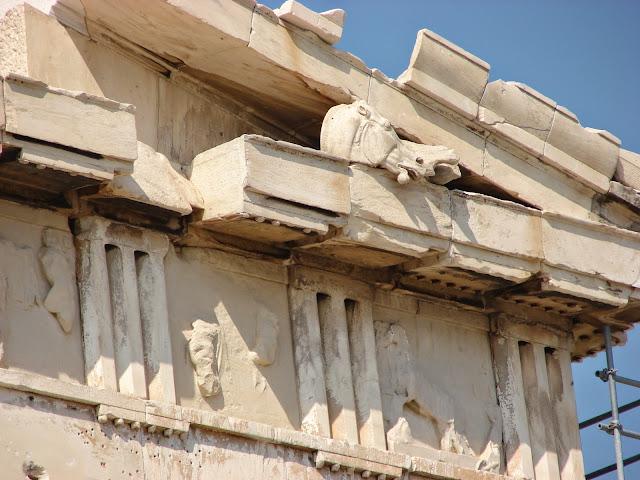Acropolis – is a sacred center of ancient Athens. In the 5 century BC, in the times when Athens were at the peak of its power, on Acropolis was created gorgeous architectural ensemble in center of which was built the Parthenon – temple dedicated to the Athena.
Parthenon has been built 447-437 BC by the Ictinus and Callicrates over the ruins of the older temple which was destroyed during the Persians invasion to Greece.
Snowy guise of Parthenon dominates over Acropolis. It’s a classical Greek temple but with own peculiarities which made the Parthenon unrepeatable. Parthenon has been built as a peripter with the columns on the sides. To hide the irregularities on the Acropolis surface, ancient architects made columns different. But human eyes can’t discern this. For us Parthenon seems ideal and harmonious.
Parthenon’s walls, columns and pediments were built from the big marble blocs. The roof of the temple (which is not survived) was wooden. One of the most prominent parts of the building was the magnificent frieze with the scenes of Athena life. According to other version on the frieze were depicted 192 heroes of Maraphon battle which took place in the 490 BC. It’s the modern version and it’s disputable.
The main, eastern, pediment of Parthenon was adorned with “Birth of Athena” frieze. According to the legend Athena was born from the Zeus head. In center of frieze was depicted the Zeus with just born Athena nearby. Over them was depicted Irida (the ancient gods newsmaker) who spread the news about Athena among the other Olympic gods. And of course the other gods were depicted with their amazement.
At the western pediment of Parthenon was depicted the famous dispute between the Athena and Poseidon.
Today Parthenon (better to say its ruins) has a white color. But in ancient times it had a different guise. The pediments were colored in the blue and the friezes in the red.
The interior of the temple was divided to the two parts. The western part was used to store the treasury of Attic Sea Union. (This formation was created after the end of Greek-Persian wars under the Athens rule. It included the Athens, Greek cities on the Asia Minor shore, and Greek islands in the Aegean Sea. De-facto this formation could be called as Athens Empire because Athenians subdued other cities to their power).
At the eastern part of the Parthenon was the statue of Athena which has been made by the Phidias. This statue played fatal role in the Phidias fate. He carved themselves on the shield of Athena and Athenians condemned him in disrespect of gods. As result in the 431 BC Phidias has been jailed.
The Parthenon began to fade in the beginning of 7 century when temple was converted into the Christian church. The interior of temple was reconstructed and its rebuilders didn’t worry about friezes safety. As result part of them including the famous “birth of Athena” was demolished.
In 1456 Athens were occupied by the Turks and Parthenon was converted into the Muslim church. The minaret has been added to its western part.
But the most devastated event occurred at the end of the 17 century during the war between Ottoman Empire and Venetian Republic. Venetians attacked the Acropolis and bombed the Parthenon because they believed that Parthenon was used as depot for gunpowder. As result Parthenon exploded after the one charge hit it.
After the few days of storm, Venetians occupied Acropolis and decided to take out some of the friezes. They did dismounting of the friezes very sloppy and part of them was crashed.
After 100 years the French envoy took some friezes to the Paris. In 1801-1803 lord Elgin took the rest friezes to the London.
My opinion that the Elgin saved the remains of the friezes for the future generations. After a few decades Acropolis again was the place of vigorous battles and I think that friezes were in the big danger. And so we can see the Parthenon friezes in the different museums today.
The Parthenon restoration began at the end of the 19 century. It’s not easy work and restoration is still in progress. I hope that in some day we will see the Parthenon as it was in the 5th century BC. Of course, even in the current state it’s very impressive and unbelievable building.





